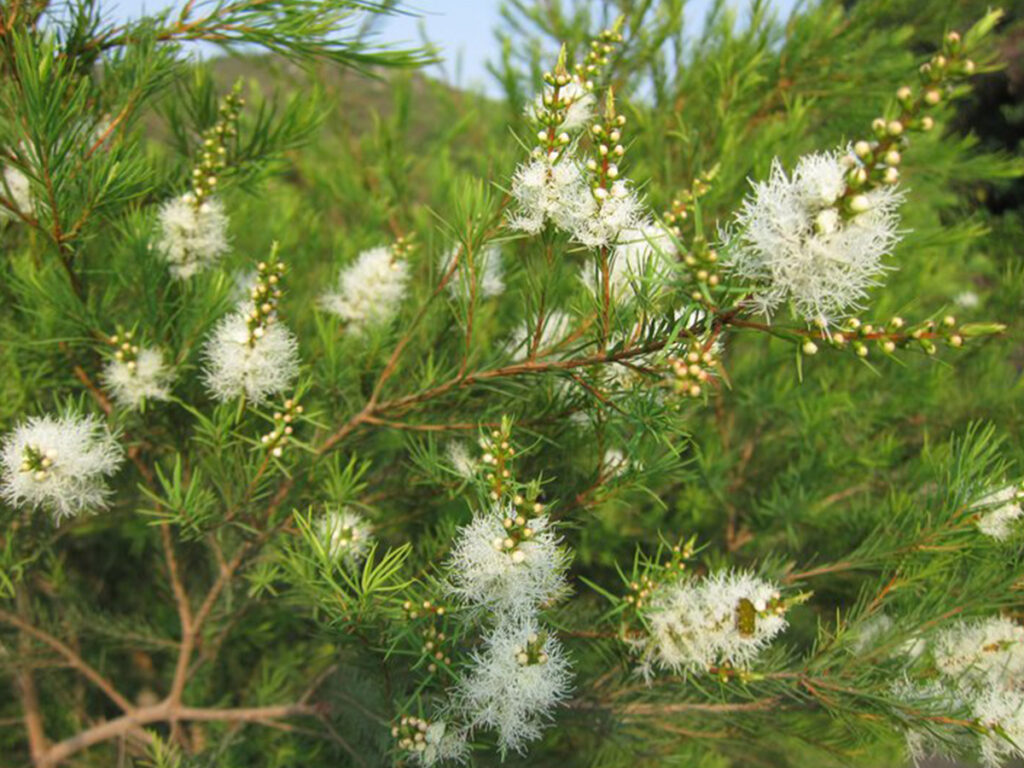L’arbre à thé ou tea tree
Melaleuca alternifolia (Maiden & Betche) Cheel
Myrtaceae
Tea tree is a tree native to Australia belonging to the myrtaceae family, such as eucalyptus or niaouli.
It was the famous navigator James Cook who was the first European to discover the plant on the Australian coast. As English as he was, he was looking for a plant to prepare his usual tea and used a tree with aromatic leaves that was called tea tree. This denomination sometimes leads to confusion with the tea plant, Camelia sinensis (L.) Kuntze. which is native to the mountains of Asia and provides the “true” tea.
Tea tree was once harvested in the wild in Australian marshes, and is now grown on a large scale, allowing the production of essential oil to grow from 8 tons in 1984 to almost 500 tons in 2001.
The aborigines who lived in southeastern Australia knew this tree and its medicinal properties well. They used it by crushing the branches with the leaves to form a paste that they applied to the weakened parts of the body or by breathing in the vapors that emerged from them.
In 1920 an Australian researcher, Arthur of Raman Penfold, distilled Tea tree leaves with water vapor and confirmed the incredible antiseptic and antibacterial properties of the essential oil extracted from this plant. Compared to a classic antiseptic at the time, the carbolic acid, the tea tree was 13 times more potent. In 1930, a Sydney surgeon published in the Medical Journal of Australia a study on the effectiveness of essential oil for the cleansing of surgical wounds.
During the Second World War, tea tree essential oil was incorporated into the first aid kits of soldiers. Antibiotics then eclipsed the use of essential oils since the 1950’s, but the appearance of resistant germs could change that.
Tea tree is effective, for example, on staphylococci, which are responsible for nosocomial infections in hospitals and which are resistant to antibiotics.
Tea tree is used today mainly in aromatherapy and its essential oil is considered a panacea against infections of all types. It is a natural broad-spectrum antibacterial, an antifungal and an anti-inflammatory. Another advantage: the essential oil of tea tree is very well tolerated internally and externally, which is not the case with other irritating antibacterial essential oils like cinnamon, oregano or clove.
This oil is used against rhinitis, sinusitis, infections of the skin, of the mouth … and also enters as sanitizer in lotions for the skin, shampoo or toothpastes.
Tea tree grows in a neutral, moist soil without stagnant water. It does not tolerate temperatures below -5 °. At l’Herbier du Diois, we grow it in pots and it is visible in the garden of the herbier from May to October.
Purifying lotion
Mélanger
Huile essentielle de tea tree 0,5g
Dispersant (type disper) 2g
Ajouter à
Hydrolat de lavande fine 97,5g
Mélanger
Appliquer le soir sur les zones à problèmes (bouton ou points noirs)
A conserver au frais, à homogénéiser avant usage
